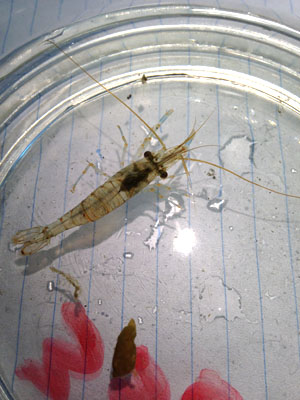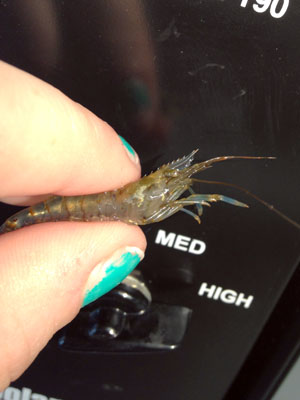
RI Coastal Resources Management Council
...to preserve, protect, develop, and restore coastal resources for all Rhode Islanders

...to preserve, protect, develop, and restore coastal resources for all Rhode Islanders
Invasive European Grass shrimp spotted in RI
NARRAGANSETT – The invasive European Grass shrimp Palaemon elegans was recently discovered in Rhode Island by a group of college students and the R.I. Coastal Resources Management Council’s (RICRMC) invasive species field monitoring supervisor.
The University of Rhode Island summer biology class, taught by CRMC field supervisor Niels Hobbs, confirmed the shrimp’s presence at Black Point, just north of Scarborough Beach in Narragansett in late May, while the group was out on a field survey. As of today, no other specimens have been discovered in Rhode Island, though Hobbs said it is possible they exist.
The shrimp, a recent arrival to North America from Europe and the Mediterranean, was first discovered in Salem Sound in 2010. Associated with docks and inshore along rocky coasts and tide pools, P. elegans is often found in dense algal growth and in protected, shaded spots. The CRMC began monitoring for this species in 2013, one of now-five distinct tasks conducted each year under its Rhode Island Aquatic Invasive Species (AIS) Management Plan and monitoring program:
“The CRMC has worked diligently to create and maintain a cooperative research relationship with URI and we are pleased and grateful that this partnership has produced good scientific evidence indicating that aquatic invasives species are, in fact, a real and growing problem in Rhode Island waters,” said Kevin Cute, CRMC marine resources specialist and manager of the CRMC AIS program. “We credit Niels Hobbs as URI’s expert in AIS, and the relationship with him, URI, and his students is invaluable.”
Hobbs said he takes the class to a different coastal site each day, and usually the group will monitor at Black Point once or twice.
“It’s a nice, classic rocky shore with tide pools, and we caught a bunch of shrimp, and when we took them back to the lab, this one was among the natives,” he said. One of his students, Chloe Salomone, made the actual confirmation. As for the discovery, Hobbs said, “It’s a funny, mixed feeling for sure.”
And while Hobbs said he’s been expecting P. elegans’ arrival since last year, given how quickly it has spread in neighboring Massachusetts and Maine, he still wasn’t prepared to discover it at Black Point. Creating a record of an invasive species’ introduction into Rhode Island waters, however, is an important milestone for the monitoring program.
“It’s important to have that early arrival record, so now we know what the (native) population looked like prior to its arrival,” he said. “Now we can see if it’s going to be a problem species – not just to the native shrimp, but to other native species that might feed on native shrimp, or now might switch over to feed on this one.”
For more information on the Rhode Island Aquatic Invasive Species Management Plan (administered by the CRMC), or AIS in general, go to: http://www.crmc.ri.gov/invasives.html. (Photos of the shrimp are available upon request.)

